Tom's Hardware Verdict
With best-in-class speed and image quality and a 1000R curve, the Samsung 49-Inch Odyssey G9 delivers a wonderful and unique gaming experience. A bright backlight, accurate color, killer HDR and speedy 240 Hz ensure you’ll be fully immersed in your virtual world.
Pros
- +
+ Bright, sharp picture
- +
+ Accurate color out of the box
- +
+ Excellent HDR
- +
+ Fast, responsive
- +
+ Tight curve delivers maximum immersion
Cons
- -
No motion blur reduction
- -
No speakers
- -
No framerate counter
- -
Expensive
Why you can trust Tom's Hardware
Gaming monitors with a 21:9 aspect ratio, aka ultrawide monitors, have established their relevance and usefulness in the gaming genre. A wide variety of sizes and curve radii are available from 34-38 inches diagonally and curves from 1800R to 3800R. But the more extreme specs are found in the megawide category, where you’ll find 32:9 49-inch. These displays are laser-focused on gaming, and their extreme size and curve are better suited for entertainment.
We’ve looked at two other high-res, 32:9 screens -- the AOC Agon AG493UCX and Viotek SUW49DA -- both with a very tight 1800R curve radius. But here comes Samsung with its latest Odyssey G9, the LC49G95T. The Samsung 49-Inch Odyssey G9 has the most extreme curve we’ve seen yet, 1000R, and is one of the best gaming monitors we’ve tested. At a comfortable viewing distance of 2-3 feet, it completely fills your peripheral vision. But that’s not all, it’s a really good-looking monitor too.
Samsung 49-Inch Odyssey G9 (LC49G95T) Specs
| Panel Type / Backlight | SVA / W-LED, edge array, quantum dot film |
| Screen Size / Aspect Ratio | 49 inches / 32:9 |
| Row 2 - Cell 0 | Curve radius: 1000mm |
| Max Resolution & Refresh Rate | 5120x1440 @ 240 Hz |
| Row 4 - Cell 0 | FreeSync: 60-240 Hz |
| Row 5 - Cell 0 | G-Sync Compatible |
| Native Color Depth & Gamut | 10-bit / DCI-P3 |
| Response Time (GTG) | 1ms |
| Brightness (mfr) | 420 nits SDR |
| Row 9 - Cell 0 | 1,000 nits HDR |
| Contrast (mfr) | 2,500:1 |
| Speakers | None |
| Video Inputs | 2x DisplayPort 1.4 |
| Row 13 - Cell 0 | 1x HDMI 2.0 |
| Audio | 3.5mm headphone output |
| USB 3.0 | 1x up, 2x down |
| Power Consumption | 66.5w, brightness @ 200 nits |
| Panel Dimensions WxHxD w/base | 45.2 x 16.5-21.1 x 16.4 inches (1148 x 419-536 x 417mm) |
| Panel Thickness | 11.5 inches (292mm) |
| Bezel Width | Top/sides: 0.4 inch (10mm) |
| Row 20 - Cell 0 | Bottom: 0.7 inch (17mm) |
| Weight | 36.8 pounds (16.7kg) |
| Warranty | 3 years |
Samsung starts with a VA panel in mega-wide QHD resolution, 5120 x 1440. That’s the equivalent of two 27-inch 1440p monitors side by side for a 32:9 aspect ratio. It also means an ideal 109 ppi pixel density, which represents a sweet spot in the performance/price spectrum. Though it requires a bit more graphics horsepower than a 2560 x 1440 monitor, it’s not quite as demanding as a 16:9 4K screen, which has a million more pixels to move about.
It also means higher speeds. The other two 49-inchers we’ve tested top out at 120 Hz but the Odyssey G9 manages 240 Hz, making it one the fastest large monitors we’ve seen yet. Samsung has also put its image quality cred into this monitor with extended color, DisplayHDR 1000 and a factory calibration. Though it has an edge-array backlight rather than the more premium full-array local dimming (FALD), it dims selectively to increase contrast for both SDR and HDR content. Our HDR tests below reveal one of the broadest dynamic ranges we’ve yet recorded.
Gaming and entertainment features are here as well. The 49-Inch Odyssey G9’s video processing is covered as well with FreeSync and G-Sync Compatibility certification from AMD and Nvidia respectively. Both technologies function at 240 Hz with HDR, and the panel has a native 10-bit color depth for smooth picture gradients.
The Odyssey G9 is well-equipped to anchor a high-end gaming system. It is premium-priced, but on paper, it has unique qualities you can’t currently find anywhere else. We should note that Samsung sells this monitor under two model numbers. The business version is called LC49G97T and has an MSRP that’s $220 cheaper than that of our review focus as of writing; however, we’ve seen our review focus sell for less. You should snag whichever one’s available for the cheapest because Samsung confirmed to us that the monitors are the same.
Assembly & Accessories
A long carton reveals the Odyssey G9 in three pieces. Once you’ve attached the large but slender base to its substantial upright, it bolts to the panel with four fasteners held captive in the mount. You won’t have to fish around for the tiny hardware bag, but you will need a Phillips-head screwdriver to complete assembly.
Get Tom's Hardware's best news and in-depth reviews, straight to your inbox.
A plastic trim ring snaps in place at the panel’s pivot point to create the RGB lighting effect on the attachment point at the back of the monitor. Bundled cables include DisplayPort and USB. The power supply is internal, and the provided IEC cord has convenient right-angled plugs.
Product 360
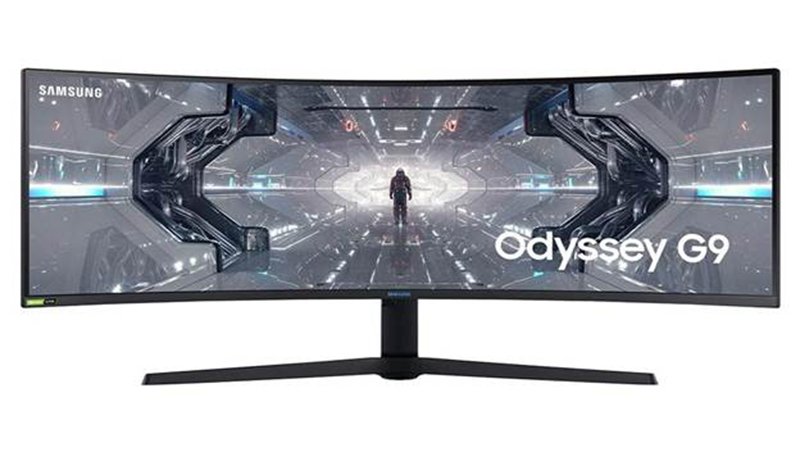


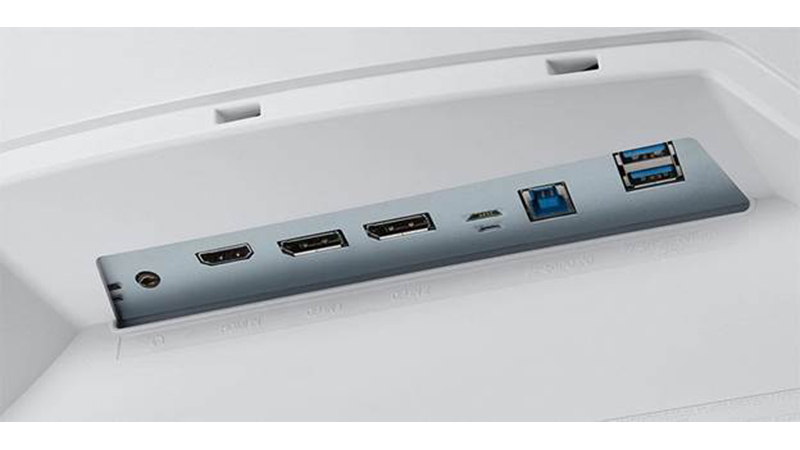
Any talk of the G9’s physical attributes must include words like “large” and “wide.” However, the front bezel is very thin at just 10mm around the top and sides and 17mm across the bottom. There, you’ll find a small Samsung logo and the G-Sync certification sticker. If you look very hard, you’ll see a microscopic, blue power LED. It certainly won’t distract you. The control joystick is the only way to toggle power and navigate the OSD. At this price point, a handheld remote would be nice.
Obviously, there is no attempt at slimness here. The side view is something you won’t see anywhere else. The back panel is an unbroken white piece with a few style lines molded in. A thin vent cuts across the top with a large black circle at the attachment point. This is actually smoked and transparent when the customizable lighting effect on the back of the stand is turned on. You can specify colors and effects for the RGB in the monitor’s on-screen display (OSD).
Tucked well up and under the panel are the inputs. Once you’ve made connections, a cover snaps in place to tidy up the wiring. Inputs are a single HDMI 2.0 and two DisplayPort 1.4s. You also get USB 3.0 (one up and two downstream) and a 3.5mm headphone jack. Despite the price, there are no built-in speakers.
OSD Features
The 49-Inch Odyssey G9’s OSD has the same control panel look as other Odyssey G-series screens with status roundels at the top of all menus that show refresh rate, Adaptive-Sync and more and is divided into six sub-menus.
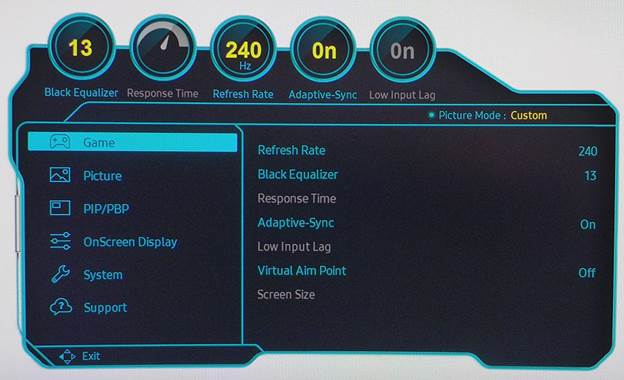
Game is where the important things are. That includes refresh rate, which must be set at 240 if you want 240 Hz, Black Equalizer, which increases shadow detail visibility, response time (overdrive) and the Adaptive-Sync toggle.Interestingly, overdrive is grayed when Adaptive-Sync is on, but our tests indicated it was operating because we saw no blur or ghost artifacts behind moving objects.
The Game section also has options for low input lag, (which is automatically on in most picture modes), aspect ratio and aiming points, an array of reticles in red or green.

The G9 offers eight picture modes that include different game types and an accurate sRGB preset. You can maintain the correct color gamut for SDR in this mode and retain the brightness adjustment. HDR signals automatically employ the full extended color space with their own specific image preset. This is a rare monitor that allows brightness adjustment in HDR mode -- a good thing considering it can top 1,300 nits.
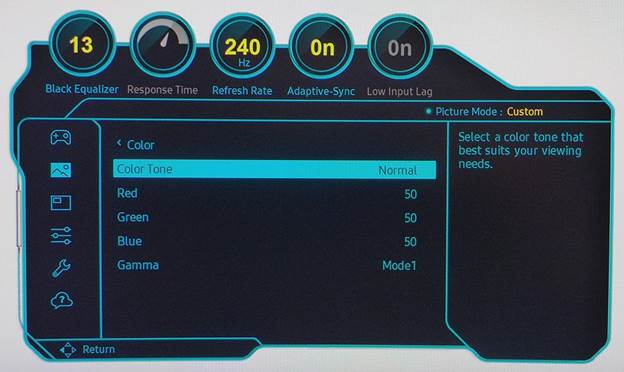
You can calibrate the G9 in its Custom picture mode, but there’s little point. The monitor comes out of the box in a very accurate state, and we were unable to make any improvements via calibration. Leave the settings as you see them in the third photo above, and you’ll see the G9’s best possible picture.
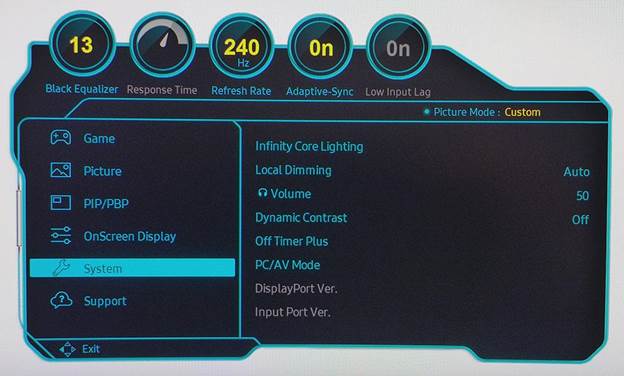
The system menu has the rest of the monitor’s convenience options and the local dimming option. Auto works well for both SDR and HDR content and leaves brightness available so you can set the peak output anywhere you wish. Dynamic Contrast is also effective with two levels of aggressiveness. Standard leaves the brightness adjuster available, while Ultimate grays it out and displays a very bright and contrasty image.
Here also is the Infinity Core Lighting sub-menu, which offers color and effect options for the LEDs around the panel’s attachment point in back.
Samsung 49-Inch Odyssey G9 Calibration Settings
The 49-Inch Odyssey G9 ships in its Custom picture mode and does not require calibration. In fact, we could not improve accuracy with any adjustments we tried. The Normal color temp is right on D65, and gamma mode 1 is perfectly in line with the 2.2 spec. Color gamut accuracy is also excellent for both DCI-P3, plus sRGB if you choose the sRGB mode. Below are the brightness settings for various light output levels.
| Picture Mode | Custom |
| Brightness 200 nits | 19 |
| Brightness 120 nits | 6 |
| Brightness 100 nits | 4 |
| Brightness 80 nits | 1 (min. 73 nits) |
Gaming & Hands-on
You’ll need almost 4 feet of desk width and around 17 inches of depth to accommodate this 49-incher. Luckily, its height means you won’t have to back away too far, like you would from a large 16:9 screen. Sitting at the usual 2-3 feet is ideal. The pixel structure is invisible, and the sides of the screen are just visible at the edge of peripheral vision.
The anti-glare layer is very effective, which is good because avoiding reflections with a screen of this shape and size would be difficult. It’s still a good idea to avoid sunny windows, as they can wash out parts of the image. But it is bright enough to combat medium to bright room lighting.
1000R is really curved. But the G9 is so wide that image distortion isn’t a problem. When working, documents are at or near the screen’s center. We couldn’t perceive any distractions there.
On paper, the Odyssey G9 looks like it wouldn’t be good for much besides gaming. But after a few afternoons spent in web browsers and spreadsheets, this proved not to be the case. Though moving windows around looked a bit like watching objects float in a fishbowl, the distortion wasn’t noticeable with a document simply placed in front of our view. The monitor proved great for keeping extra windows open on the sides for things like stock tickers or news crawls. Though it’s sized like two 27-inch monitors, it behaves more like three screens. And all parts of the image are in focus when you move your eyes or head. It’s an ideal curvature.
The Custom picture mode works well for all content if you don’t mind a little extra color saturation. sRGB is there if you need accuracy or are a purist, but with 88% coverage of DCI-P3 SDR material doesn’t look oversaturated on the G9. And you can use HDR in Windows without penalty. The brightness control remains available if you want to dial down the output, but even with brightness set to its maximum, the Windows desktop never looked too harsh.
We experimented with the Local Dimming and Dynamic Contrast options using both static and moving images. Local Dimming is a toggle, off or auto. Dynamic Contrast has two levels, the more aggressive of which grays out the brightness control and makes the picture quite vivid. It’s usable for games or videos but only for short periods. The Standard option is a little easier on the eyes and allows for brightness adjustments. It increased contrast nicely without clipping any highlight or shadow detail.
Gaming was a lot of fun with the G9. It’s a completely unique experience, different from the other two 49-inch megawides we’ve reviewed. The 1000R curve creates an environment around you that truly feels immersive. If you turn off the room lights, it isn’t much different than VR goggles. Add good speakers or headphones, and you have a true sensory experience when playing first-person games.
In Tomb Raider, we quickly adapted to moving our head and eyes to pick up action to the outer sides of the screen. A little extra advance warning of enemy attacks from the sides gave us an edge when approaching structures. The suspension of disbelief is on another level here.
The pixel load was enough that our GeForce RTX 3090 couldn’t quite max the framerate at 240 frames per second (fps) but stayed around 200 fps, more than enough to keep action smooth. We noticed that with Adaptive-Sync on, overdrive became grayed out. We didn’t miss it though, because there were no trails behind moving objects. Motion blur was visually non-existent. We made use of the aiming points from the Game menu but missed a frame counter. FRAPS had to be engaged to monitor our play speeds.
With HDR turned on, we explored both dark and bright environments in Call of Duty: WWII. Night scenes took on a lot of depth with true blacks in the shadow areas. The edge dimming backlight occasionally showed itself when a highlight lit up a vertical area of the screen. But that artifact was infrequent. Framerates only dropped slightly to 150-160 fps. Detail was still sharp and tactile. We noticed in a building interior there were visible swirl marks on the polished floor, where a machine had obviously cleaned. That’s pretty impressive. Fans of HDR games will be more than satisfied with the G9. It’s one of the better HDR monitors we’ve played on.

Christian Eberle is a Contributing Editor for Tom's Hardware US. He's a veteran reviewer of A/V equipment, specializing in monitors. Christian began his obsession with tech when he built his first PC in 1991, a 286 running DOS 3.0 at a blazing 12MHz. In 2006, he undertook training from the Imaging Science Foundation in video calibration and testing and thus started a passion for precise imaging that persists to this day. He is also a professional musician with a degree from the New England Conservatory as a classical bassoonist which he used to good effect as a performer with the West Point Army Band from 1987 to 2013. He enjoys watching movies and listening to high-end audio in his custom-built home theater and can be seen riding trails near his home on a race-ready ICE VTX recumbent trike. Christian enjoys the endless summer in Florida where he lives with his wife and Chihuahua and plays with orchestras around the state.